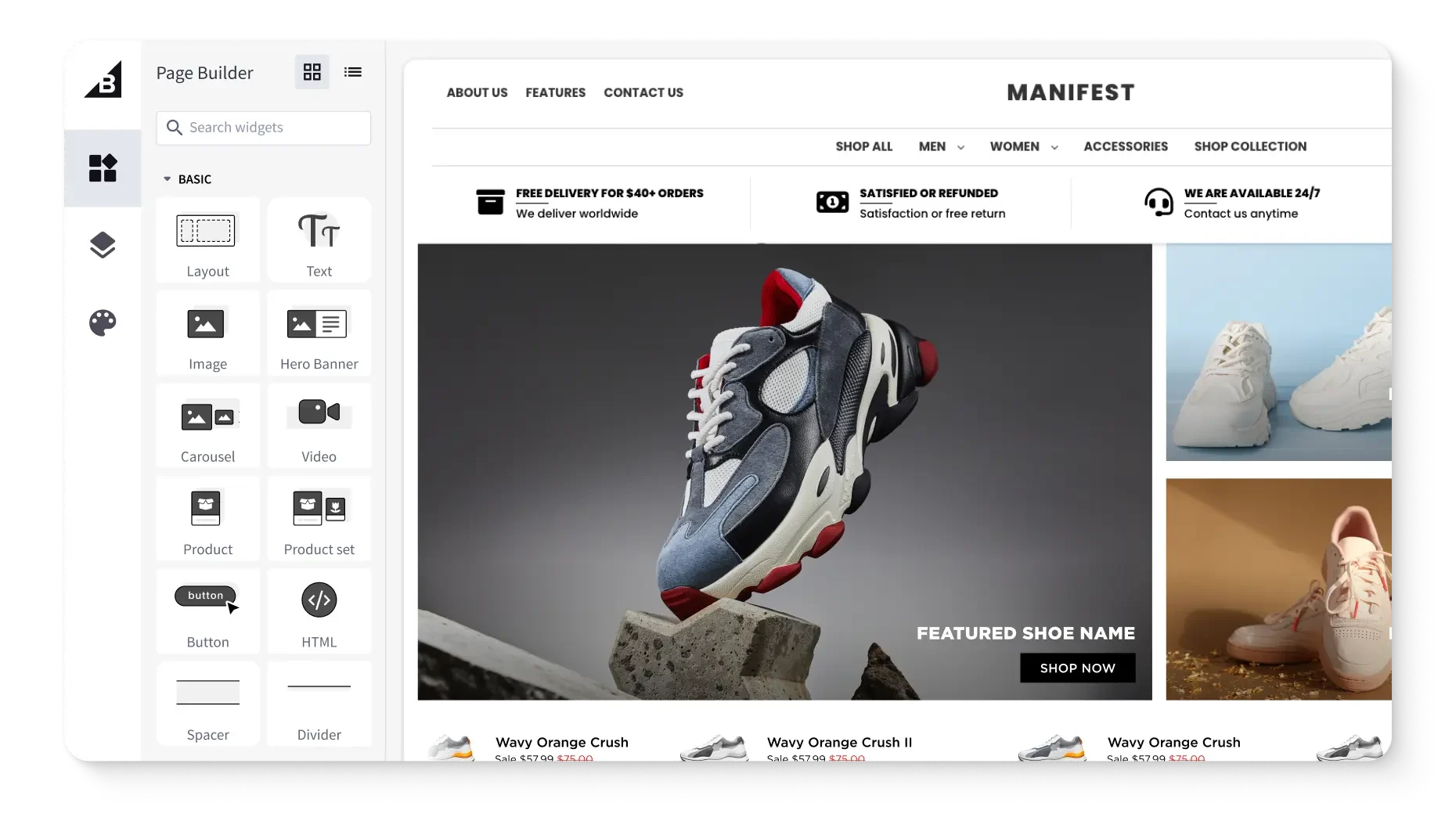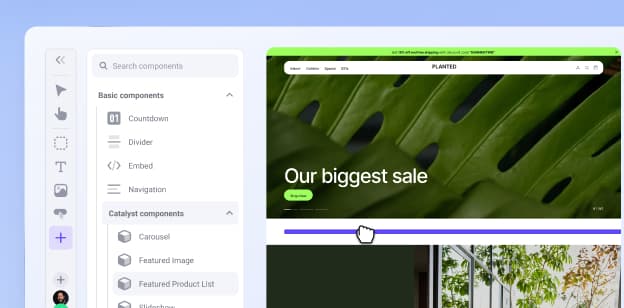
Create Ecommerce Website
Get The Print Version
Tired of scrolling? Download a PDF version for easier offline reading and sharing with coworkers.
A link to download the PDF will arrive in your inbox shortly.
Success used to mean finding the perfect storefront, printing a stack of business cards, and relying on foot traffic or phone calls to bring in customers.
Today, the landscape has shifted.
Over 25% of all transactions now happen through online shopping, and 73% of small business owners have already established a website to meet customers where they are. Whether you sell to consumers, other businesses, or both, building an ecommerce business offers an opportunity to reach more buyers, streamline operations, and grow beyond the limitations of your in-person footprint.
An online store can work for you 24/7 — showcasing your product listings, taking orders, and building lasting customer relationships without the need for a full sales team or retail location.
With the right focus and a few key building blocks in place, your ecommerce solution can quickly become one of your most valuable business assets — helping you drive sales, build trust, and scale sustainably in an increasingly digital world.
The importance of an ecommerce website
An ecommerce website is more than a digital storefront — it’s a central hub for your business operations, online payments, and marketing efforts. It allows you to meet your target audience where they shop, streamline your checkout process, and operate around the clock without the limits of a physical location.
Whether you’re selling physical products, digital products, or both, the right online store builder will help you manage everything from inventory to promotions in one centralised backend. Today’s platforms also offer powerful automation tools that simplify repetitive tasks like order routing, payment processing, and customer notifications.
Highlight your brand.
Your website should instantly communicate who you are and what you offer. A clean, mobile-friendly template that reflects your brand’s personality sets the tone from the start.
Upload your logo, use consistent fonts and colour palettes, and feature high-quality imagery that showcases your new products or services in action. Strong website design reinforces your brand identity and builds trust with visitors.
Equally important is thoughtful web design, which ensures easy navigation, fast performance, and a seamless experience across mobile devices and desktop.
You can enhance your storefront even more with customisable elements and marketing tools that support your specific business needs.
Establish trust and credibility.
When someone visits your homepage for the first time, trust is everything. Clear, customer-friendly policies — including shipping, returns, and privacy — signal professionalism.
Add an “About” page to share your storey, include real contact information (like an email address or phone number), and link to active social media profiles to show you're a legitimate business. Use an SSL certificate, recognizable payment gateways like Stripe and PayPal, and fast-loading pages to help convert new customers into loyal customers.
Offering familiar payment methods, including credit card, PayPal, and mobile wallets, and complying with PCI standards adds extra reassurance during checkout.
Drive new sales with digital marketing tactics.
Getting your site live is only the beginning — attracting customers is what turns it into a sales engine. Start with the essentials: optimise your product descriptions, product pages, and product categories for search engine optimisation using built-in SEO tools, promote your store on social media, and build an email list from day one.
Create automated email campaigns for promotions and cart recovery. Leverage email marketing to re-engage past buyers and keep your brand top of mind.
Platforms like Amazon, eBay, and Etsy can help extend your reach if you sell physical products. You can also connect to additional sales channels through apps and plugins that support omnichannel growth.
Consider adding a blog to your site to boost visibility in search engine results and support long-term growth. Following a step-by-step strategy ensures you build the right foundation for success.
Understand the integrations needed for your business model
Your ecommerce website builder is the foundation of your online business, influencing everything from how your site looks to how you manage your backend operations. Choosing the right one depends not just on your technical skills, but also on who you’re selling to.
If you’re a B2C business, you may prioritise features like mobile-optimised themes, upselling tools, and connections to dropshipping providers. For B2B businesses, you might need more advanced functionality — such as customer-specific pricing, real-time inventory syncing, POS integrations, and multi-user customer support portals.
Popular platforms like BigCommerce, Shopify, WooCommerce, Squarespace, Wix, and open-source tools like WordPress offer a range of capabilities. Think about your web hosting, scalability, and available shipping options and payment methods — including how your payment processor handles transaction fees — before making a decision. Also consider whether you want to use a custom domain or domain name to reinforce your brand presence.

Ebook: How to Stay Ahead in Ecommerce
We surveyed 155 retail executives to see how they're adapting to the ever-changing technology of ecommerce.
Considerations when creating an ecommerce store
Launching an ecommerce website doesn’t need to be overwhelming. With the right mindset and a clear focus on what matters most, startups and small businesses can get online quickly, start selling, and refine over time. Platforms like BigCommerce are built to support sellers at every stage, with scalable tools that grow alongside your business.
Launch before your site is perfect.
It’s easy to obsess over perfect layouts or flawless images, but those things shouldn’t delay launch. Focus on creating a functional store with complete product listings, reliable payment methods, and a working shopping cart. Many online store builders include built-in tutorials and support for setting up everything from product pages to shipping rates.
You can always refine your design and expand your capabilities later with custom web development as your business grows.
Design your store with tools anyone can use.
Even without a development background, platforms like BigCommerce empower you to build a modern, effective store using drag-and-drop content tools, pre-designed themes, and customisable checkout process templates. The platform’s user-friendly interface, built-in features, and robust app marketplace make it easy to manage everything from fulfillment to email marketing and online payments.
Understand and acquire a business ID.
Before you can accept payments, you’ll need to legally register your business and obtain a business ID — such as an EIN (Employer Identification Number) in the US. This step is required by most payment providers and is a crucial part of setting up a legitimate business.
Choose the right domain and site structure.
Pick a short, memorable custom domain that aligns with your brand. More importantly, design your site’s navigation and product categories around how your customers naturally shop. BigCommerce gives you full control over your site structure, so you can create intuitive paths to conversion based on how your audience thinks and buys.
Prepare your store for launch.
Before you launch your store, test every step of the buying process — from browsing and checkout to order confirmation and fulfillment. BigCommerce makes it easy to configure your shipping options, adjust shipping rates, and test workflows before going live. Once everything’s working, use your launch to build momentum and capture early feedback.
Drive traffic on a budget.
Use free and low-cost tactics like search engine optimisation, social media, and email marketing to build awareness and attract traffic. Tools like BigCommerce include built-in SEO tools, multi-channel integrations, and support for automated email campaigns, so you can reach the right audience across the right platforms without overspending.
Create a promotional strategy that converts.
Promotions don’t need to be complex. Run seasonal offers, highlight new products, or use email campaigns to boost traffic and conversions. Many ecommerce platforms, such as BigCommerce, offer built-in marketing tools that help schedule, track, and optimise promotions with minimal effort.
Balance a quick launch with professionalism.
Launching fast doesn’t mean sacrificing quality. Use a polished template, apply consistent branding, and include trust-building elements like secure payment options, PCI compliance, clear return policies, and a contact page. These details go a long way in showing that your online store is credible and ready for business.
The final word
Building an ecommerce website may seem daunting at first, but with the right platform, features, and marketing tools, it becomes a powerful step toward growing your business. Modern ecommerce solutions like BigCommerce give you the flexibility and functionality to launch quickly and scale with confidence.
With a user-friendly interface, customisable templates, and access to built-in tutorials and support, even non-technical users can create a beautiful, effective online store tailored to their business needs.
Start with the basics, take a step-by-step approach, and remember — perfection isn’t the goal. Progress is. Your ecommerce website isn’t just a storefront; it’s the gateway to everything your business can become.
FAQs about creating an online store
It depends on your budget, timeline, and the complexity of your project. Freelancers are often more affordable and flexible for smaller builds or quick fixes. Agencies may be better suited for more complex projects that require strategy, design, and development expertise under one roof. If you're launching a basic store with a ready-made theme, you may not need either.
If your store needs features that go beyond what your ecommerce platform offers out of the box — like advanced product configurators, custom checkout flows, or B2B-specific logic — you may need custom development. But if your needs are relatively straightforward, most platforms provide tools and apps that let you launch without writing code.
Look for experience with your ecommerce platform, a portfolio that aligns with your goals, and a clear process for project management and communication. Ask about their understanding of SEO, mobile optimisation, and performance. And don’t overlook cultural fit — you want a partner who understands your business and can grow with you over time.
Many ecommerce platforms offer professionally designed themes that make it easy to create a polished store without hiring a designer. That said, if you want a highly customised user experience or you're building a more complex site, a UX/UI designer can help you optimise layout, navigation, and conversion paths.
For a basic ecommerce site using a pre-built theme, you can often launch in a matter of days or weeks. More customised stores may take several weeks to a few months, depending on the scope of design, development, and content creation. Don’t wait for perfection — aim to get a functional version live, then refine over time.

Get a free 15-day trial of BigCommerce.
No credit cards. No commitment. Explore at your own pace.




